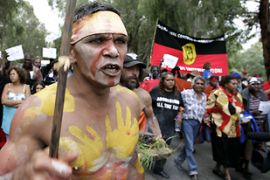Aborigine disadvantage gap widens
Report shows growing gap between Aborigines and non-indigenous Australians.

“We have to redouble and treble our efforts to make an impact,” Rudd said.
“It is unacceptable and it requires decisive action.”
Child abuse
|
“This report really does demonstrate the depth and the extent of the challenge in front of us” Jenny Macklin, |
According to the report’s authors aboriginal children are six times more likely to be abused or neglected than non-indigenous children, a worsening of the situation since the last survey was conducted two years ago.
In 2003, the first year of the report, abuse in Aboriginal communities was said to be four times as likely.
It also shows there has been no improvement in literacy and numeracy since the last survey of Aboriginal living standards two years ago.
Indigenous Australians are also 13 times more likely to go to prison.
Aborigines make up about two per cent of Australia’s 22 million population and are the poorest and unhealthiest minority.
The average life expectancy for a member of the Aboriginal community is at least 10 years shorter than other Australians.
Underspending
One positive note was on infant mortality, which the report said had improved for Aborigines in most states and territories.
However, it was still two to three times higher than for non-indigenous Australians.
Jenny Macklin, Australia’s federal indigenous affairs minister, said there had been a history of government underspending in indigenous housing, education, health and employment.
“This report really does demonstrate the depth and the extent of the challenge in front of us,” she said.